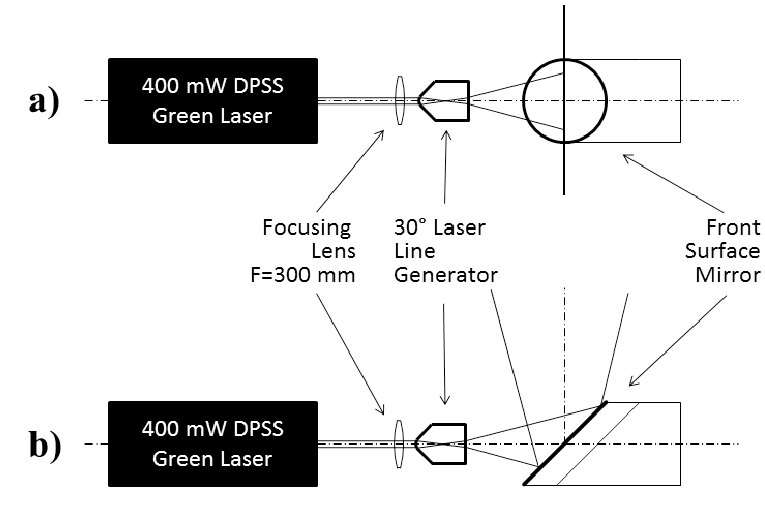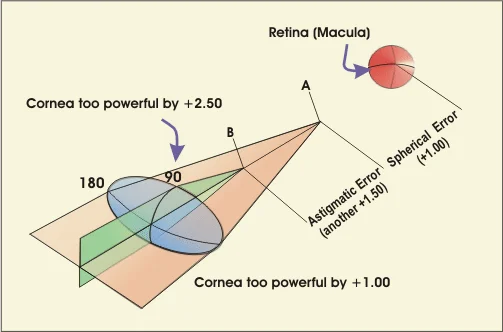Cylindrical lens introduction
Cylindrical lenses (also called cylindrical or semicylindrical lenses) are lenses with differing radii in their X and Y axes, creating cylindrical or semicylindrical shapes with image magnification in only a single direction. Common uses for laser line generators include setting laser lines at various distances or altering image height sizes or correcting for astigmatism in imaging systems. Lenses designed to focus light into a straight line rather than to one point can either be plano-concave or plano-convex in design; either will expand and focus light respectively. Cylindrical lenses may only focus or expand light along a single axis and may be used to alter laser beam profiles such as correcting for astigmatism and ellipticity or generate lines.
Types of Cylindrical Lenses

Cylindrical lenses come in various styles to meet specific optical requirements. Some common varieties include:
Cylindrical lenses serve a number of important purposes in various applications, from creating single laser lines in laser scanning systems, shaping light beams for imaging applications and correcting astigmatism in laser diodes to shaping light beams for imaging and creating single imager laser lines in imaging applications.
Uses
Cylindrical lenses have multiple applications across different industries and fields. Some common examples are:
These lenses are specially constructed to concentrate or expand incoming light in one dimension or axis, making them invaluable tools for many optical applications.
Uses in Optometry

Cylindrical lenses have many uses within optometry, from correcting astigmatism to helping focus light from different angles of your eye at various distances – all to address specific refractive errors associated with astigmatism. Cylindrical lenses also play a crucial role when used alongside eye examination instruments like autorefractors for measuring and correcting refractive errors during eye exams.
Create A Laser Line Generator

To create a laser line generator, cylindrical lenses can help focus the laser beam into a line with controlled length and thickness determined by their radius and laser beam cross sectional size. By selecting an appropriate cylindrical lens you can control its length and thickness as desired by choosing its radius/cross-section size ratio and choosing an appropriate cylindrical lens thickness ratio based on laser module fan angle fan output. You may also utilize various products and DIY solutions available for creating laser line generators including optics modules compact laser modules and DIY solutions which may then be utilized for machine vision/microscopy/alignment tasks among many more tasks!
Create Circular Beams

A popular method for producing circular beams from an elliptical one involves two cylindrical lenses; one magnifying minor axis of laser diode while a second cylindrical lens circles out its path – this method leads to circularized laser beams with greater efficiency than ever. This process can effectively change an elliptical beam into a circular one for various applications. Cylindrical lenses are purposefully created to focus or expand light along a single axis and are frequently employed for beam shaping purposes such as line generators and circularization of laser beams. Cylindrical lenses make an invaluable asset when manipulating light in one direction only and they play an invaluable role in optimizing laser beam characteristics for specific tasks.
What Makes Cylindrical Lenses Worth Considerating?
Cylindrical lenses play an integral part in various industries and applications due to their ability to focus, condense or expand light along a single axis – making them well suited to fulfilling many optical tasks. Cylindrical lenses’ primary benefits are as follows:
Cylindrical lenses possess many useful properties that make them indispensable tools in various industrial, semiconductor, optometry imaging, spectroscopy and other fields of study. Their ability to control light along a single axis ensures precision and accuracy across various optical systems and instruments.
How Do Cylindrical Lenses Work?

Cylindrical lenses are specifically designed to focus light in an even line rather than at one particular point, rather than creating focal spots along their specific axes. Their cylindrical or semi-cylindrical forms contain differing radii in their X and Y axes to cause image magnification along only one particular direction. Cylindrical lenses come with various designs to condense, focus, or expand light depending on their design and the source of illumination they’re directed toward. Light spreaders, commonly made out of either plano-concave or plano-convex lenses designed to expand and focus light sources, come either in diameter or rectangular shapes to facilitate mounting. These lenses are widely utilized as laser line generators, to adjust image height size or correct for astigmatism in imaging systems, or correct for astigmatism in those systems. Their special properties make them well suited to serve a diverse selection of functions including laser beam shaping, imaging systems, spectroscopy manufacturing processes and optometry applications.
Considerations When Selecting Cylinder Lenses
Considerations when applying cylindrical lenses are vital in order to ensure their effective use, including manufacturing methods, specifications and applications of these lenses. Some key points include:
Taken into consideration, users can ensure cylindrical lenses are being utilized efficiently for their intended applications, whether that’s lasers systems imaging tasks or any other optical task.
When using cylindrical lenses, several essential considerations come into play – wedge angle, centration and axial tilt are among them.
Considerations such as these are necessary for the specification, production, and integration of cylindrical lenses into optical systems for maximum performance and accuracy.
If you want to buy cylindrical lenses for your applications, please Contact our experts for a consultation.
Cylindrical vs Spherical lenses

Cylindrical lenses and spherical lenses differ considerably when it comes to their optical properties and applications, here are the key differences:
Spherical lenses are best-suited to imaging full field of view imagery while cylindrical lenses excel at focusing light along a path, including correcting astigmatism or laser line generation.


